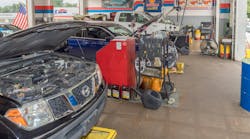There's good news and less than good news in the automotive care business these days. The good news is that folks are keeping their vehicles longer. The average age of cars and light trucks on the road is pushing 12 years. There are several reasons for this, but one that is significant is the initial cost of a vehicle - second only to the cost of a home. The longer they keep them, the more maintenance they'll require. Auto manufacturers can take a bow here, as well. The quality of construction, as well as fit and finish is at its highest level since Henry Ford started the production line.
The less than good news is that with oil change intervals being recommended at anywhere from 6,000 to 10,000 miles and the generally robust construction of modern vehicles, there's not much work to be done coupled with longer oil change intervals. The resulting reduction in car count at any store creates some very special challenges. There are a lot of other services that can be rendered, and that's where a good plan can make the difference.
Let's look at two potential approaches to improving the bottom line at your business. The first way is based on efficiency and is the least expensive in terms of equipment. Simply stated, are you capturing every bit of cost savings in your current operation? Take some time to go over the process. From the time your customer drives up to your store until the time he drives off, there are many steps that can make or break your business.
The first major challenge is the speed of the oil change. While not directly related to oil changes, most people can't deal with any type of service that takes more than about 20 minutes. Speakers are cautioned to keep it short when delivering a message. The same probably can be said for customers wanting an oil change. If you are typically taking more than 20 minutes, you're not really a fast oil change. Target for 15 minutes, since that will be the sweet spot for your customers.
So how can you make things go faster? Have your service writer ask the right questions up front. Things like, "What oil do you want to use?" or, "Do you want the deluxe service?" are examples. Make sure the customer doesn't have to wait long and, preferably, waits in the car. If your customer can have the oil change done without exiting the car, so much the better. In fact, moms with small kids in car seats actually would appreciate that.
If you have a waiting room, make sure it is really clean and pleasant to be in. If there is a coffee pot, be sure it has fresh coffee in it and there is sugar and creamer in place. If you can move cars through in 15 minutes, magazines are probably not needed but a TV can help.
Be sure to have a very fast pay system that can be utilized while in the car. Most people pay with credit cards, so be sure to accept the biggest names. There are many devices that can swipe a card and collect the necessary card information. For cash sales, be sure to have change readily available.
In the November 2017 issue of NOLN, the late Joe Haggard laid out 12 essential factors for success in the fast oil change business. The lessons from this article, coupled with analyzing where you can improve performance, will add to your bottom line.
If you feel that you need to add services to your operation, there are a number of steps to make the best decision. The following list will help with the successful introduction of additional services.
- What are the possibilities: While there are any number of possible additions, there are some realities to take into consideration. For instance, is there enough room to add a service? If you want to add equipment that takes up a large amount of space, do you have that space available? If you have a two-bay facility, adding a service that needs a bay will cut your oil change business potential. If the service you are considering is one that takes a lot of time (for example brake jobs) you effectively tie up 50 percent of your oil change capability. Customers want to be able to get the oil change done quickly, so many will go elsewhere.
- Cost: If you have identified suitable space for a service, does it require a large capital investment? Some work requires very little in additional cost. If you can check tires for air pressure and can rotate tires easily (but not in the bay), you may have a winner. Of course, you'll need to consider tire balancing as well.
- What do your customers want: It won't make any sense to add a service that is not needed by your customers, so find out what would be of interest to them. The way to do that is to survey selected customers for their input. Make a list of possible services, taking into account what you've learned about space and cost. When a customer comes in for an oil change, ask them if any one of the possibilities would be something they'd consider having you do. You'll probably need around 100 responses to get a feel for what would be of most value to them and to you.
- Profitability: After a few weeks and sufficient number of jobs done, see if you are making a suitable profit. Make sure that you include wages and all the other requirements for a real profit analysis. If it doesn't measure up to what you thought, adjust your price. Don't be bashful about charging what it really takes to justify the additional service.
There are a number of additional services that can be added to a facility. Each has its own set of issues and needs. It can pay to add some references; online is best, to aid with the more difficult problems. If you are not planning to create a full-service shop, find resources for your customers such as a good repair shop or specifics such as muffler, brake or tire stores that you know and believe to be quality operations. Nothing is better for a customer than to get a referral from you to an honest and skilled business. Make sure that those shops you are referring your customers to know it's you who is referring them. Working out some sort of informal reciprocity arrangement with them, so they'll do the same for you, is ideal.
Whatever you decide to do, make it outstanding and let your customers know what you are doing. A good promotion is always a winner for new offerings as well as a commitment to exceed your customers' expectations.





